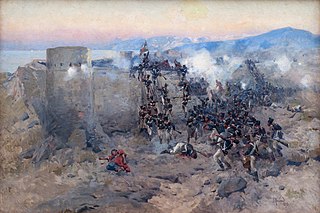 W
WThe Austro-Hungarian military mission in Persia was the development of a military organization in Qajar Persia in 1879 by Austria-Hungary, which is considered as part of efforts to reform the Persian army under Naser al-Din Shah and set up a standing army in Persia. The Association had the strength of a corps.
 W
WA Franco-Persian alliance or Franco-Iranian alliance was formed for a short period between the French Empire of Napoleon I and Fath Ali Shah against Russia and Great Britain between 1807 and 1809. The alliance was part of a plan to gather extra aid against Russia and by Persia's help, having another front on Russia's southern borders, namely the Caucasus region. The alliance unravelled when France finally allied with Russia and turned its focus to European campaigns.
 W
WKazakh sultanate or Gazakh sultanate was established at the end of the XV century. During the Safavid Empire, it was part of the Karabakh principality. In 1605, by the decree of Abbas the Great, Shamsaddin sultan of Kazakh was given the rank of Khan.
 W
WThe khanates of the Caucasus, or Azerbaijani khanates or Persian khanates, or Iranian khanates,were various provinces and principalities established by Persia (Iran) on their territories in the Caucasus from the late Safavid to the Qajar dynasty. The Khanates were mostly ruled by Khans of Azerbaijani origin and were vassals and subjects of the Iranian shah (King). Persia permanently lost a part of these khanates to Russia as a result of the Russo-Persian Wars in the course of the 19th century, while the others were absorbed into Persia.
 W
WThe Persian Gulf Residency was an official colonial subdivision of the British Raj from 1763 until 1947, whereby the United Kingdom maintained varying degrees of political and economic control over several states in the Persian Gulf, including what is today known as the United Arab Emirates and at various times southern portions of Persia, Bahrain, Kuwait, Oman, and Qatar.
 W
WQajar Iran, also referred to as Qajar Persia, the Qajar Empire, officially the Sublime State of Persia and also known then as the Guarded Domains of Persia, was an Iranian empire ruled by the Qajar dynasty, which was of Turkic origin, specifically from the Qajar tribe, from 1789 to 1925. The Qajar family took full control of Iran in 1794, deposing Lotf 'Ali Khan, the last Shah of the Zand dynasty, and re-asserted Iranian sovereignty over large parts of the Caucasus. In 1796, Mohammad Khan Qajar seized Mashhad with ease, putting an end to the Afsharid dynasty, and Mohammad Khan was formally crowned as Shah after his punitive campaign against Iran's Georgian subjects. In the Caucasus, the Qajar dynasty permanently lost many of Iran's integral areas to the Russian Empire over the course of the 19th century, comprising modern-day Georgia, Dagestan, Azerbaijan and Armenia.
 W
WThe Russian conquest of the Caucasus mainly occurred between 1800 and 1864. In that era the Russian Empire expanded to control the region between the Black Sea and Caspian Sea, the territory that is modern Armenia, Azerbaijan, Georgia, and parts of Iran and Turkey, as well as the North Caucasus region of modern Russia. Multiple wars were fought against the local rulers of the regions, as well as the dominant powers, the Ottoman Empire and Persian Empire, for control. By 1864 the last regions were brought under Russian control.
 W
WThe Russo-Persian War of 1826–1828 was the last major military conflict between the Russian Empire and Persia.
 W
WThe Sceriman family, also referred to as the Shahremanian, Shahremanean, Shahrimanian, Shehrimanian, Shariman, or Seriman family, were a wealthy Safavid merchant family of Armenian ethnicity. A Catholic family, they had their roots in early 17th-century New Julfa, and relatively quickly came to preside over branches all over the world, stretching from Italy in the west, to Pegu (Burma) in the east. Apart from being renowned as a trader's family, some Scerimans were high-ranking individuals in the Safavid state, including in its military, religious, and bureaucratic systems. Later, similar positions were obtained abroad, such as in the various Italian city-states and the Austro-Hungarian Empire. They especially became renowned in the Republic of Venice, where they were well integrated into its ruling class. Nevertheless, until their decline in the late 1790s and eventual inactivity in the 19th century, they remained bound to their original base in Iran.
 W
WShamshadil, Shamshaddil, or The Sultanate of Shamshaddil was a sultanate established in 1747. Its area was 4,200 versts, and the population mainly consisted of Zulgadar clan, taking roots from the Qizilbash Turkic tribes. The sultanate was located near Lake Sevan and covered the territories of the modern day Tavush Province in Armenia and some parts of Tovuz District in Azerbaijan, with the center in the village of Oksuzlu, in the territory of Tovuz.
 W
WThe Storming of Lankaran took place on 1 January 1813 as part of the Russo-Persian War (1804-1813). It was noted for its bitterness and cruelty.